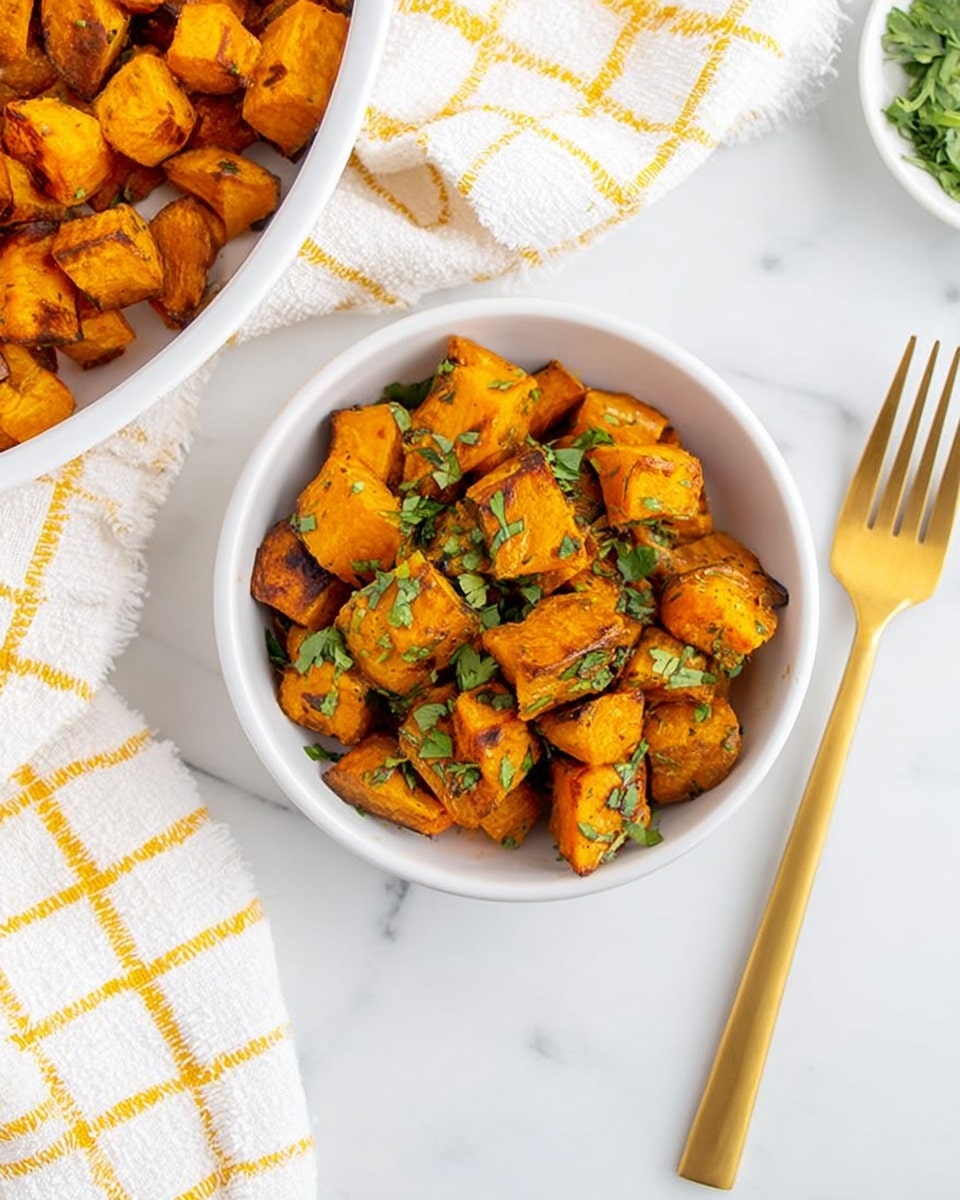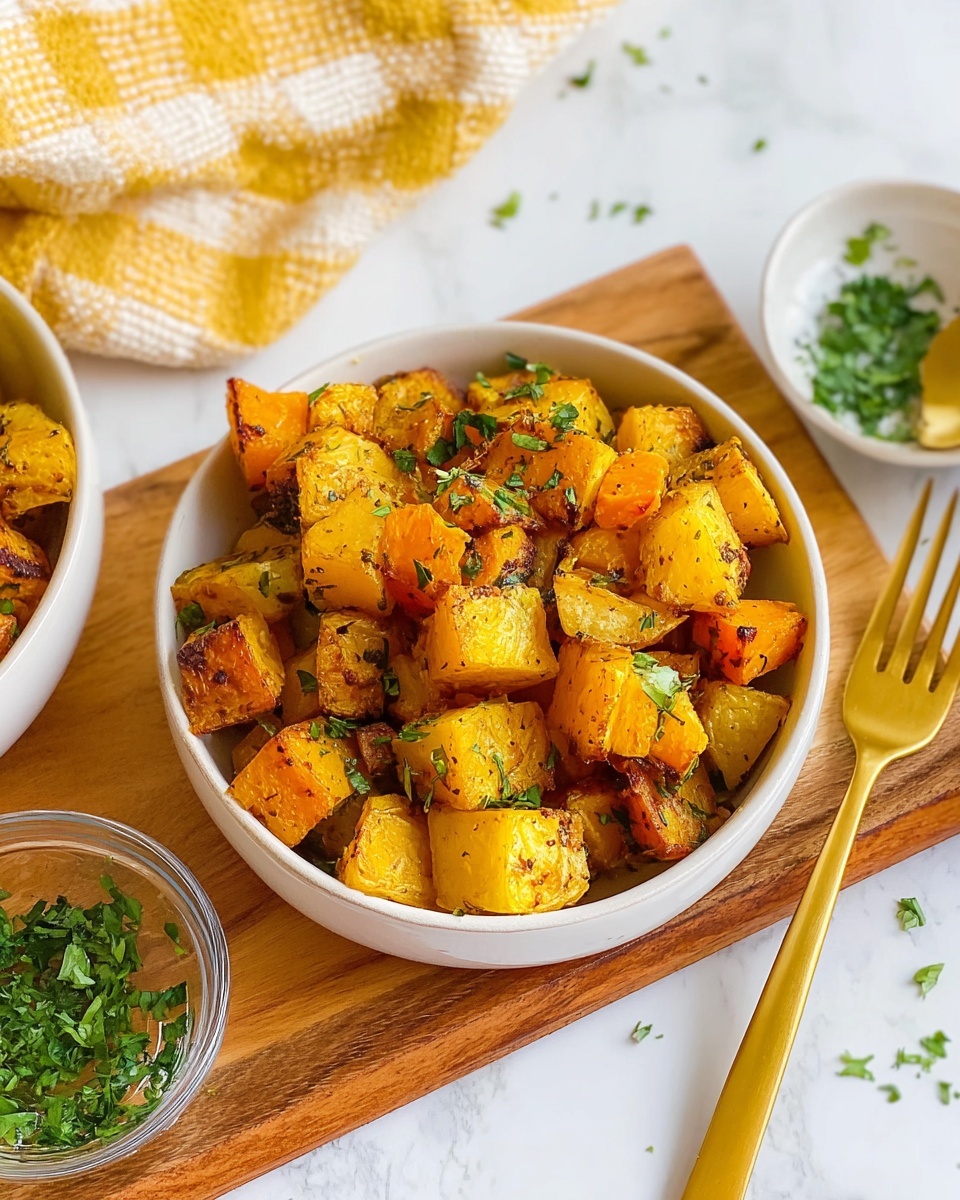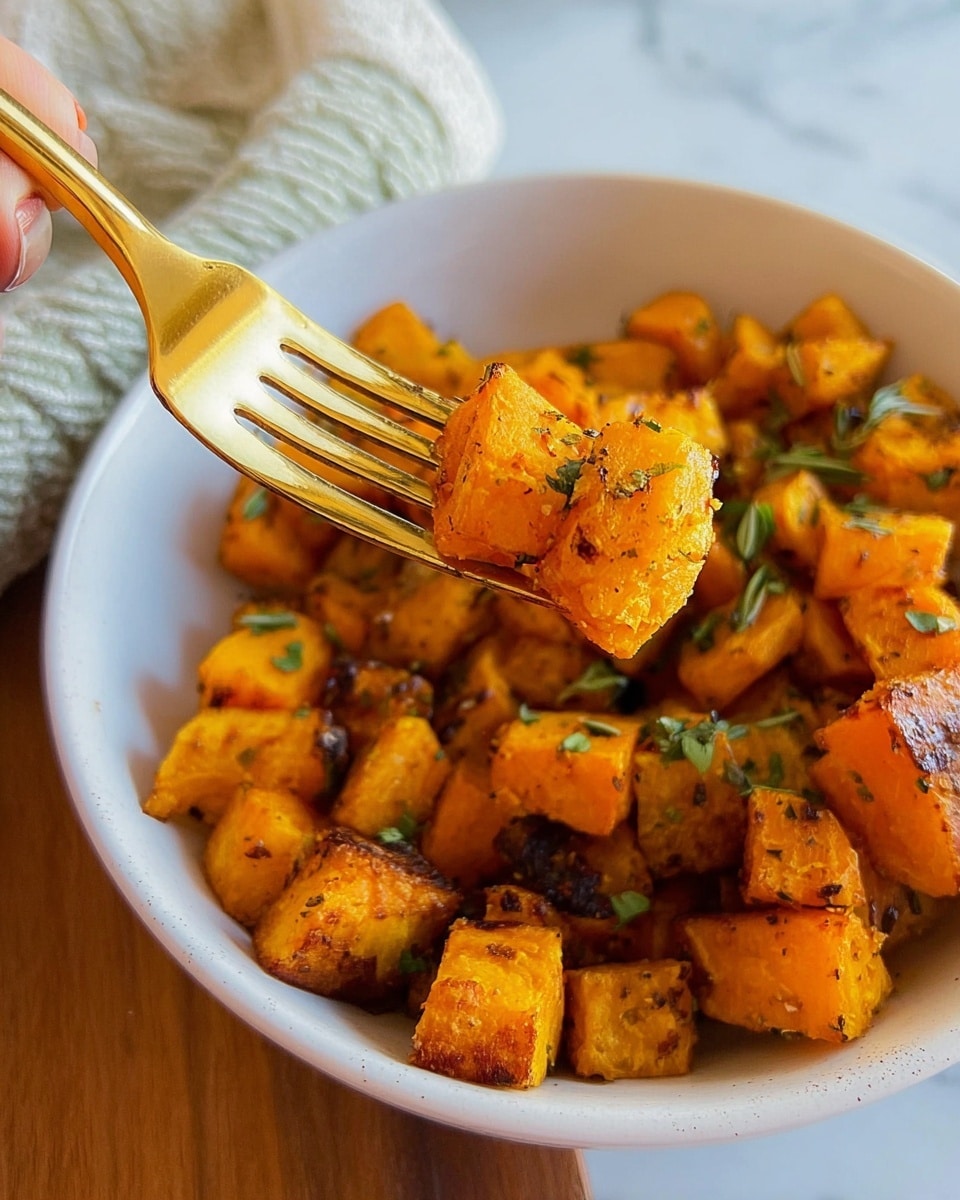I absolutely love this Maple-Roasted Butternut Squash Recipe because it’s such a cozy, hands-off way to enjoy one of my favorite fall veggies. The sweetness from the maple syrup combined with the warm hint of cinnamon turns simple roasted squash into something special—it’s like autumn on a plate. Whenever the weather starts to cool down, this dish is my go-to side that feels both comforting and a little indulgent without being over the top.
What makes this recipe really stand out is how effortless it is to pull together, yet the result tastes like you’ve spent hours in the kitchen. You’ll find that the natural sugars caramelize beautifully when roasted with the maple syrup, giving every bite that perfect balance of sweet and savory. Plus, it’s incredibly versatile—whether you’re serving a casual weeknight dinner or dressing up a holiday spread, this Maple-Roasted Butternut Squash Recipe always hits the spot.
Why You’ll Love This Recipe
- Simple Ingredients: You only need a handful of pantry staples to bring out the best in butternut squash.
- Hands-Off Cooking: Just toss and roast—perfect when you’re juggling too many things in the kitchen.
- Perfect Sweet-Savory Balance: The maple syrup and cinnamon combo keeps every bite flavorful without overwhelming sweetness.
- Family Favorite: My family goes crazy for this dish and it disappears fast every time I make it.
Ingredients You’ll Need
The beauty of this Maple-Roasted Butternut Squash Recipe lies in the simplicity and quality of its ingredients. Using fresh butternut squash combined with real maple syrup and a few spices really brings the dish to life. When shopping, I recommend choosing a firm, unblemished squash for the best texture and flavor.
- Butternut Squash: Look for one that feels heavy for its size and has smooth, unwrinkled skin.
- Olive or Avocado Oil: Both oils have a nice flavor and a high smoke point, perfect for roasting.
- Maple Syrup: Go for pure maple syrup, not pancake syrup, to get that authentic rich sweetness.
- Cinnamon: Freshly ground cinnamon adds a warm, cozy note without overpowering the squash.
- Coarse Salt: I like flaky sea salt for a little texture and to enhance all the flavors.
- Pepper: Freshly cracked black pepper adds a subtle kick that balances the sweetness.
Variations
I love experimenting a bit with this Maple-Roasted Butternut Squash Recipe depending on the season or what’s in my pantry. It’s so easy to personalize! You can add spices, swap oils, or even change up the garnish—all without much effort but with big flavor impact.
- Add Nutmeg or Ginger: When I want extra warmth, a pinch of freshly grated nutmeg or ground ginger really elevates the spice profile beautifully.
- Swap Maple for Honey: Sometimes I use honey instead of maple syrup for a different kind of sweetness that still caramelizes nicely.
- Use Coconut Oil: For a dairy-free, coconutty twist, roasting with coconut oil adds a subtle tropical note I really enjoy.
- Add Toasted Pecans: Sprinkling chopped toasted pecans after roasting gives a crunchy texture contrast that my whole family adores.
How to Make Maple-Roasted Butternut Squash Recipe
Step 1: Prep Your Squash and Oven
Start by preheating your oven to 400°F. While it’s heating up, peel, seed, and chop your butternut squash into bite-sized chunks—about 1-inch pieces work best for even roasting. I usually cut them a bit smaller when I want them to caramelize faster, but beware of pieces that are too tiny, as they might burn more easily.
Step 2: Toss with Oil, Maple Syrup, and Spices
In a large bowl, combine the chopped squash with olive or avocado oil, maple syrup, cinnamon, salt, and pepper. I like to toss everything with my hands to ensure the squash pieces are evenly coated so they roast up with those lovely caramelized edges. Don’t rush this step—it makes a world of difference in flavor and texture.
Step 3: Spread and Roast
Line a baking sheet with parchment paper or grease it lightly, then spread the squash out in a single layer—crowding the pan will steam the squash instead of roasting it, which you want to avoid. Roast for 15 minutes, then use a spatula to gently toss the squash so it browns evenly on all sides. Roast an additional 15 to 20 minutes until the edges are golden and tender, checking occasionally so nothing burns.
Step 4: Garnish and Serve
If you’re feeling fancy, fresh chopped Italian parsley sprinkled on top adds a touch of brightness and color that I really enjoy. Serve it warm as a side dish alongside your favorite main course—my family loves it with roasted chicken or pork.
Pro Tips for Making Maple-Roasted Butternut Squash Recipe
- Uniform Pieces: Cutting squash into evenly sized chunks ensures they cook at the same rate for perfect texture.
- Use Parchment Paper: It helps prevent sticking and makes cleaning up afterward a breeze.
- Don’t Skip the Tossing: Stirring halfway through promotes even browning and caramelization, giving you maximum flavor.
- Avoid Overcrowding: Give squash room on the pan so it roasts instead of steaming—this is key for crispy edges.
How to Serve Maple-Roasted Butternut Squash Recipe

Garnishes
I often garnish this dish with freshly chopped Italian parsley or a sprinkle of toasted pumpkin seeds for a delightful crunch. Sometimes I add a drizzle of extra maple syrup or a dusting of ground cinnamon if I want to emphasize the cozy flavors even more.
Side Dishes
This recipe pairs wonderfully with roasted chicken, pork tenderloin, or even a hearty quinoa salad. For a vegetarian meal, serve it alongside a grain bowl or a bean-based dish—my family loves it with a savory lentil stew.
Creative Ways to Present
For special occasions, I like to serve the maple-roasted butternut squash over a bed of arugula or baby spinach, garnished with pomegranate seeds for a beautiful burst of color and tartness. You can also use it as a warm salad topping or mix it into a roasted vegetable medley to make a vibrant centerpiece.
Make Ahead and Storage
Storing Leftovers
I store leftover maple-roasted butternut squash in an airtight container in the fridge, where it keeps well for about 3 to 4 days. When stored properly, the squash doesn’t lose its lovely roasted flavor or texture.
Freezing
Freezing roasted squash is totally doable but I recommend freezing it flat on a baking sheet first, then transferring it to a freezer bag. This prevents the pieces from sticking together and allows you to thaw just what you need. The texture is a bit softer after freezing, but the flavors stay intact.
Reheating
To reheat, I prefer using the oven or toaster oven at 350°F for about 10-15 minutes to get the edges crisp up again. Microwaving works in a pinch, but it can make the squash a bit mushy, so if you care about texture, go for oven reheating.
FAQs
-
Can I use frozen butternut squash for this recipe?
You can, but frozen squash tends to release more moisture and may not caramelize as well as fresh. It’s best to thaw and pat it dry before roasting, and expect the texture to be a bit softer.
-
Is there a substitute for maple syrup in this recipe?
Yes! Honey, agave, or even brown sugar mixed with a splash of water can work as alternatives. Just remember that pure maple syrup adds a distinct flavor that’s hard to replicate exactly.
-
Can I make this recipe vegan?
Absolutely—the recipe is naturally vegan as long as you use plant-based oil and pure maple syrup. It’s a perfect fit for vegan and vegetarian diets.
-
How do I get the squash perfectly caramelized?
Make sure not to overcrowd your baking sheet and toss the squash halfway through roasting. Also, keep the oven hot at 400°F so the sugars in the maple syrup can do their magic.
Final Thoughts
This Maple-Roasted Butternut Squash Recipe has become a staple in my kitchen because it’s reliable, delicious, and incredibly comforting. I encourage you to give it a try the next time you want something simple but impressive. It’s one of those dishes that feels special enough for company but easy enough for a busy weeknight—plus, your whole family will thank you!
Print
Maple-Roasted Butternut Squash Recipe
- Prep Time: 5 minutes
- Cook Time: 30 minutes
- Total Time: 35 minutes
- Yield: 6 servings 1x
- Category: Side Dish
- Method: Baking
- Cuisine: American
- Diet: Vegetarian
Description
A delicious and simple Maple-Roasted Butternut Squash recipe featuring tender, caramelized squash cubes tossed with olive oil, maple syrup, cinnamon, and seasoning, perfect as a comforting side dish for any meal.
Ingredients
Ingredients
- 8 cups chopped butternut squash
- 2 tablespoons olive or avocado oil
- 2 tablespoons maple syrup
- 1 teaspoon cinnamon
- 1 teaspoon coarse salt
- 1/2 teaspoon pepper
- Optional: Italian parsley for garnish
Instructions
- Preheat Oven: Preheat your oven to 400°F (200°C) to prepare for roasting the squash evenly.
- Mix Ingredients: In a large bowl, combine the chopped butternut squash with olive or avocado oil, maple syrup, cinnamon, coarse salt, and pepper. Toss until squash pieces are evenly coated.
- Prepare Baking Sheet: Grease a baking sheet with oil or line it with parchment paper to prevent sticking.
- Arrange Squash: Spread the coated squash pieces in a single layer on the prepared baking sheet to ensure even roasting.
- Initial Bake: Bake the squash for 15 minutes in the preheated oven to start caramelizing and softening.
- Toss Squash: Carefully toss the squash using a spatula to turn the pieces for even browning during the second bake.
- Final Bake: Return the squash to the oven and bake for another 15 to 20 minutes or until the edges turn golden brown and the squash is tender.
- Serve: Optionally garnish with freshly chopped Italian parsley and serve warm as a flavorful side dish.
Notes
- Use olive or avocado oil for a healthy fat option and subtle flavor.
- Maple syrup adds natural sweetness and helps with caramelization.
- Adjust cinnamon and seasoning to taste for a spiced or savory profile.
- Roasting time may vary slightly depending on your oven and squash size.
- Garnish with parsley for a fresh, colorful finish.
- Leftovers can be stored in an airtight container in the fridge for up to 3 days.
Nutrition
- Serving Size: 1 cup
- Calories: 90
- Sugar: 5 g
- Sodium: 220 mg
- Fat: 4.5 g
- Saturated Fat: 0.6 g
- Unsaturated Fat: 3.9 g
- Trans Fat: 0 g
- Carbohydrates: 12 g
- Fiber: 2.5 g
- Protein: 1 g
- Cholesterol: 0 mg



